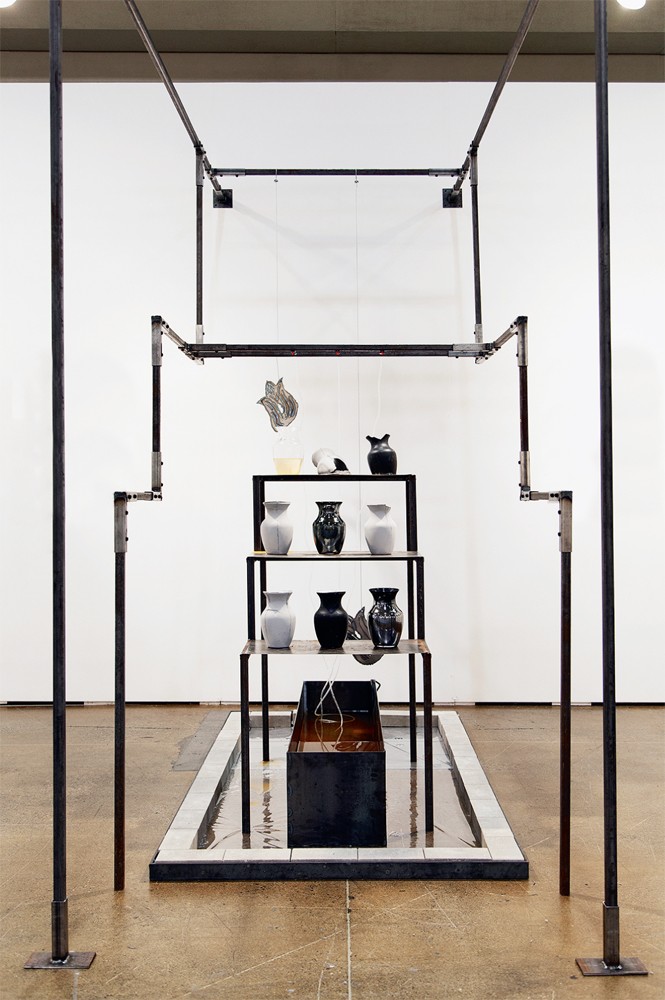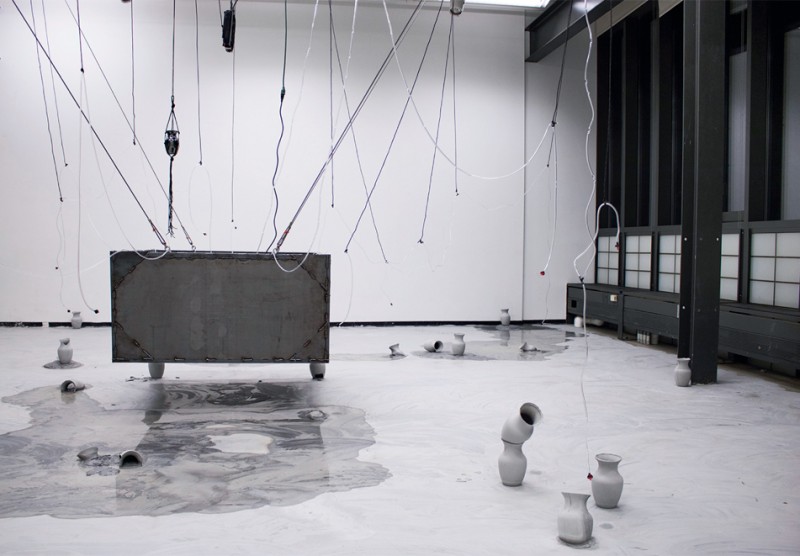Vapour and Steel
Entropy is an idea that hasn’t worn out. It was central to the thinking and writing of Robert Smithson in the mid-’60s, and the psychologist and theorist Rudolf Arnheim wrote about the concept in his canonical 1971 essay on disorder and order. Entropy deals with uncertainty and randomness; it negotiates a space between decay and renewal, between order and chaos; and it attempts to detect the process of energy as it transfers from one thing or condition to another. Pessimistic interpretations of the idea have been especially prominent. Smithson recognized that the attitude among artists was that “energy is more easily lost than obtained,” and the sculptor Jean Arp had a particularly pessimistic view of its aesthetic and philosophical workings. He admitted that “the dying of a painting no longer brought despair. I had made my pact with its passing,” and he added, “but death grew and ate up the picture and life.”

Azza El Siddique, Break Up to Break Down, 2018, steel, unfired slip casts, glass, latex paint, water slow drip irrigation system. Courtesy Projet Pangée, Montreal, and the artist.
The attitude of Azza El Siddique, a Sudanese-born Canadian artist now studying sculpture at Yale University, is that art, through her elegantly deteriorating sculptural installations, will more likely eat up death. For her, entropy is a condition ideally suited for understanding the complexities of our relationship to life and death, and art is the conduit for exploring that complexity. In the last year alone, El Siddique has made three installations that use a wide range of materials, including steel, glass, unfired clay slip, cement bricks, aircraft wire, incense, perfume oil, vinyl, humidifiers and slow-dripping irrigation systems as a way to design spaces for meditation and close looking. Bodies of Water was shown in New Haven; Let Me Hear You Sweat at Cooper Cole in Toronto; and Break Up to Break Down, a piece made for Montreal’s Projet Pangée, was installed at Art Toronto. The reversal in the naming of this last work carries with it her sense of emergent renewal. In her lexicon, the process of breaking down intractably leads in the opposite direction. Break Up to Break Down adapts the narrative of the Amduat, the ancient Egyptian funerary text where the pharaoh keeps deferring his death by moving through a liminal zone in which he could be either descending or ascending.

Azza El Siddique, Break Up to Break Down, 2018, steel, unfired slip casts, glass, latex paint, water slow drip irrigation system. Courtesy Projet Pangée, Montreal, and the artist.
Her installations show us what could be described as a process of observable collapse, but that is the wrong word. She would call it “transformation.” In thinking about her sculpture, you have to change the way language is understood and how you describe what you are seeing. Words like “collapse,” “decay,” “destruction,” “broken” and “fractured” are all misapprehensions. Within a framework that views transformation as a generative force, any of the pejorative associations normally applied to these words simply don’t apply.
El Siddique’s engagement with the positive effects of change carries through the way she reads the history of objects and architecture. In her view, the ruin is a place or a thing that “exists in a perpetual state of becoming,” which is to say that she doesn’t really believe that ruins exist. There is immanence in her installations but no permanence. They intimate evidence of change and slow transformation.

Azza El Siddique, Bodies of Water, 2018. Installation view. Courtesy the artist.
A similar thing happens with the word “stain.” Because so many of her pieces mix water with other substances, like metal and unfired clay slip, an inexorable process of material collapse occurs. When rust appears on the floor of her installation, or a stain is produced when her vessels disintegrate, she doesn’t see what remains as a problem: “I think there is something very beautiful and poetic with the residue of something that was there.” She uses material to create contradictory qualities; the effect is simultaneously delicate and rough, lyric and industrial. In Let Me Hear You Sweat, vapour becomes a counterweight to steel.
At the core of her work is a movement back and forth between presence and absence. The thing that contains both those conditions is the body. Many of the objects she includes (the vessels and the metal containers) are corporeal surrogates. “I am interested in the body,” she says, “without necessarily having the body there.” What is often there, though, is the trace of the body’s presence, in the scent of Bakhoor, an incense favoured by the women with whom she grew up, and in the perfumed imprint of sandalaya oil. “There is something about Bakhoor that is comforting and intoxicating,” she says. “Scent is this other material that creates an agency within the space, and because it is a residue that’s left on the viewer, it also extends the space.”

Azza El Siddique, Bodies of Water, 2018. Installation view. Courtesy the artist.
The surrogate body is also a deferred presence, and it makes a direct connection to El Siddique’s ongoing interest in entropy. “Essentially, I think I’ve been trying to grapple with mortality. In order for me to understand life, I try to understand death,” she says. “It goes back to entropy. Death is another state of being and that is where the transfer of energy comes in.” There is a notion in Leaves of Grass, Walt Whitman’s epic celebration of life, that tells us “every blade of grass proves there is no death.” I think of Azza El Siddique’s installations as materialized rituals. In that spirit, she would take Whitman’s fine conception and apply it to her own life and art. For her, then, every ritual recognizes a different way of understanding that there is no death. ❚

